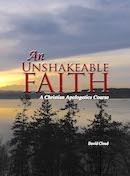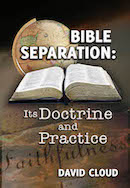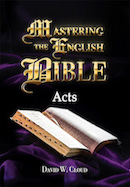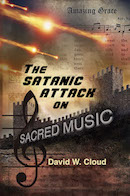866-295-4143, fbns@wayoflife.org
The following is from the new book SEEING THE NON-EXISTENT: EVOLUTION’S MYTHS AND HOAXES, which is available from Way of Life Literature.
The Scopes trial of 1925 is a major evolutionary icon, allegedly proving that evolution has won over the Bible and Christianity, but the way it is typically presented is a myth. In particular, the 1960 Hollywood movie Inherit the Wind staring Spencer Tracy is a cheap propaganda piece. (The movie was based on a 1955 play by Jerome Lawrence and Robert E. Lee.)
In History of Modern Creationism, Dr. Henry Morris observed that “the Scopes trial was evolution’s great triumph...” (p. 76).
When Dr. Morris spent six weeks speaking on creationism in New Zealand in 1973, the government-controlled televisions broadcast Inherit the Wind repeatedly in each city he visited (History of Modern Creationism, p. 77).
During the Kansas School Board debate on evolution in 1999, evolutionists trotted out Inherit the Wind as a brainwashing tool.
“That very summer the leading repertory theater in Kansas City quickly changed its schedule to feature the play and use it as a veritable teaching device. Kansas University imported Hollywood actors to stage a highly public reading of the play. High school science teachers in Kansas showed the movie in class as an example of the kind of opposition science faces. And journalists, print and broadcast, used the play as a template from which to fashion their typically inaccurate and often defamatory reporting” (Jack Cashill, Hoodwinked: How Intellectual Hucksters Have Hijacked American Culture, p. 189).
The Scopes Trial was held to determine whether John Scopes was guilty of teaching evolution in a public school classroom contrary to Tennessee state law. (The law forbade any state-funded educational establishment to teach “any theory that denies the story of the Divine Creation of man as taught in the Bible, and to teach instead that man has descended from a lower order of animals.”)
The trial was arranged as a showcase by the American Civil Liberties Union in their agenda to dethrone the Bible from a position of authority in American society. It was a major milestone in man’s end-times rage against Almighty God and His holy law (Psalm 2:1-3).
“The idea of the Scopes Monkey Trial of 1925 in Dayton, Tennessee, seems to have been hatched in New York by officers of the American Civil Liberties Union (ACLU). The legal defence, which hired famous criminal lawyer Clarence Seward Darrow, was arranged and paid for by the ACLU and members of the American Association for the Advancement of Science. The ACLU released to the Tennessee newspapers a call for a teacher who would break the 1925 state law against teaching evolution” (Michael Pitman, Adam and Evolution, p. 99).
Clarence Darrow was a profane, philandering man who was willing to use any cheap trick to defend the guilty. (He was tried twice for jury tampering and bribery. Acquitted through the efforts of an equally slick lawyer, Earl Rogers, Darrow was forbidden to practice law in California.)
But Darrow was not selected merely because he was a clever lawyer. He was a committed Darwinist, an atheist who said, “I don’t care about the book above.” The weekly meetings of the Evolution Club congregated in his Chicago home. The portraits of his heroes decorating the walls of his office included Karl Marx (Hal Higdon, The Crime of the Century). A year before the Scopes Trial, Darrow had defended the wealthy teenage killers Nathan Leopold and Richard Loeb who admitted to murdering 14-year-old Bobby Franks just for “a sort of pure love of excitement.” On a lark to commit the perfect crime, the 19-year-old young men said, “It was just an experiment. It is as easy for us to justify as an entomologist in impaling a beetle on a pin” (Higdon). Leopold and Loeb were atheistic Darwinists, heavily influenced by the “God is dead” philosopher Frederick Nietzsche and by Darwin’s foremost German disciple Ernst Haeckel. Leopold said, “There is no difference between the death of a man and the death of a dog” (Higdon). Though the young men snickered through the trial and showed absolutely no remorse for their vile crime, Darrow saved them from the death penalty with the philosophy of Darwinist determination and natural selection. In his closing speech at the sentencing hearing, Darrow denounced the “old theory” that man has a free will and is accountable for his actions, which he called a “barbarous and cruel” view, calling for its replacement with a new, enlightened view of modern science that “human beings are machines determined wholly by their heredity and environment” (John West, Darwin Day in America, p. 46). He even painted Leopold and Loeb as victims of the tragedy, because they killed Bobby only “because they were made that way.” Darrow went so far as to say that blame can never be fixed on human actions, because “every influence, conscious and unconscious, acts and reacts on every living organism.”
If Darwinian evolution is true, Darrow was correct in extrapolating this deterministic philosophy, and Leopold and Loeb were right in comparing the murder of a human being with the impaling of a beetle on a pin. Can a monkey make a moral choice? If man is merely an evolved bacterium, there could not possibly be ultimate meaning to life or an absolute basis for blame and punishment. Are termites morally accountable if they weaken the structure of a house and it collapses, killing the occupants?
Leopold and Loeb’s heinous crime was definitely a product of Darwinism. As Erle Stanley Gardner, lawyer and author of the Perry Mason novels, observed: “Loeb and Leopold were merely the first bits of flotsam carried along by a swift stream, which had originated deep in the springs of changing thought and which was destined to rise to flood. Those muddy waters are still rising, and the flotsam being swept along in increasing quantities is frightening” (cited from Higdon, The Crime of the Century, chapter 13).
On the other aisle at the Scopes trial was William Jennings Bryan, a three-time presidential candidate and outspoken defender of the Bible, who assisted with the prosecution.
The trial was a great media event. It was covered by more than 200 reporters who wrote about two million words. Sixty-five telegraph operators “sent out more words to Europe and Australia than had ever before been cabled about any American event” (R.M. Cornelius, Scopes: Creation on Trial, p. 10). It was the first trial to be broadcast nationally on radio (by station WGN in Chicago).
Most of the reporting was highly biased against creationism. It was “specifically designed to destroy creationism and the fundamentalist revival which reached its climax in this media event” (Morris, p. 70). When asked why he never attended the trial sessions, one reporter answered, “Oh, I don’t have to know what’s going on; I know what my paper wants me to write” (Warren Allem, Backgrounds of the Scopes Trial, p. 92).
The image typically portrayed of William Jennings Bryan is of a sincere but bumbling and not very intelligent man, but this is nonsense. Bryan was called “The Great Commoner” because he had a heart for the common man and a gift of communicating truth in a simple way, but he was a very intelligent, studious man.
The book In His Image (1922) contains the James Sprunt Lectures that Bryan delivered at Union Theological Seminary. The very invitation to deliver these prestigious lectures is evidence of Bryan’s intellectual stature. Previous lectures had been delivered by such men as J. Gresham Machen and G. Campbell Morgan. Bryan delivered a carefully-reasoned presentation on such questions as the existence of God, the divine inspiration of the Bible, and the soul of man. From a reading of these lectures, it is obvious that he was an intelligent, well-read man.
In his discussion of Darwinism, Bryan made the following observation:
“But the Darwinian doctrine is more dangerous because more deceptive. It permits one to believe in a God, but puts the creative act so far away that reverence for the Creator--even belief in Him--is likely to be lost” (In His Image, p. 90).
That is a brilliant observation.
Contrary to Inherit the Wind, it is obvious that Bryan had read Darwin’s two major works and had understood them. His critique was devastating. Consider this:
“Darwin does not use facts; he uses conclusions drawn from similarities. He builds upon presumptions, probabilities and inference, and asks the acceptance of his hypothesis ‘notwithstanding the fact that connecting links have not hitherto been discovered.’ He advances an hypothesis which, if true, would find support on every foot of the earth’s surface, but which, as a matter of fact, finds support nowhere” (In His Image, p. 91).
Bryan described the vacuity of Darwin’s arguments perfectly.
The reason why Bryan was so hated by evolutionists in his day was that his arguments against Darwinism were effective. The same was true for Samuel Wilberforce before him.
Also entirely missing from Inherit the Wind is the fact that a major reason why Bryan opposed Darwinian evolution was its racism and its social destructiveness. The biology textbook that was used by John Scopes, Hunter’s Civic Biology, was viciously racist and promoted eugenics (racial purification). Hunger claimed that the white race represented “the highest type of all.” Following is an excerpt from the book that the ACLU championed in 1925:
“If such people [retarded, epileptics, etc.] were lower animals, we would probably kill them off to prevent them from spreading. Humanity will not allow this, but we do have the remedy of separating the sexes in asylums or other places and in various ways preventing intermarriage and the possibility of perpetuating such a low and degenerate race.”
As Jack Cashill observes, “It was specifically to check this kind of reasoning that Bryan launched his anti-evolution crusade. Needless to say, Lawrence and Lee spare the audience these trifling details” (Hoodwinked, p. 195).
At the same time, Bryan made a serious error in holding to the day/age theory and thus allowing for the possibility of millions of years of time for creation to occur.
“Probably the most serious mistake made by Bryan on the stand was to insist repeatedly that he had implicit confidence in the infallibility of Scripture, but then to hedge on the geological question, relying on the day/age theory. He had been warned against this very thing by George McCready Price. Darrow, of course, made the most of it, ridiculing the idea of people claiming to believe the Bible was inspired when its meaning was so flexible that one could make it say whatever he wished” (Morris, The History of Modern Creationism, p. 73).
Though evolutionists try to portray Bryan and all Bible believers as ignorant people, blindly following a mythical religion, it was actually the evolutionists at the trial that introduced myths into the court record and were later proved to be complete fools (though I have never seen this reported by the mainstream media).
Nebraska Man and Piltdown Man were mentioned in affidavits by “expert witnesses” Fay-Cooper Cole and Horatio Newman (professors at the University of Chicago), and Judge Raulston allowed their reports to be read into the court record on July 20, 1925.
These alleged ape-men fossils were offered as evidence of evolution.
Nebraska Man had been announced in 1922 by Henry Osborn, president of the American Natural History Museum. In June of that year, the popular and influential Illustrated London News published a two-page black and white drawing of Nebraska Man based on collaboration with Grafton Elliot Smith of the British Natural History Museum. The drawing depicts Mr. and Mrs. Nebraska Man. They are stooped and naked, human in body but somewhat ape-like in the face. The brutish caveman holds a club while his “wife” holds some small animal while looking at the male with a very stupid expression on her unattractive ape face. A couple of months before the Scopes Trial, Henry Osborn wrote that Nebraska Man “constitutes infinitesimal but irrefutable evidence that the man-ape wandered over from Asia into North America” (The Forum, May 1925).
It turned out that Nebraska Man was based upon a single tooth that was later found to belong to a pig, and not even an extinct one!
As for Piltdown Man, this missing link turned out to be a complete hoax. Doctored fragments of a 500-year-old human skull, an orangutan jawbone, and a couple of chimpanzee teeth “discovered” in the Piltdown gravel pit in Sussex in 1912 were accepted by experts at the British Museum and elsewhere as an ancient ape-man. It was given the scientific name of Eoanthropus dawsoni (“Dawson’s dawn-man”) in honor of its discoverer Charles Dawson (who probably perpetrated the hoax). For 40 years, Piltdown Man was broadcast throughout the world as a major evidence of evolution and used to silence Bible believers. A plaster reconstruction was given a prominent place in the British Museum of Natural History. Drawings, paintings, and statues of Piltdown proliferated. The one by Louis Rutot, titled “Man of Sussex,” depicted Piltdown as an ape-man (a half-ape, half-human head on a hairy human body) making a crude tool. Piltdown was adopted into textbooks, described in encyclopedias, represented at museums, introduced as evidence in the Scopes Trial, and discussed in hundreds of articles and scientific papers. Arthur Woodward of the British Museum devoted an entire book, The Earliest Englishman, to Piltdown. Finally in 1953, the British Museum announced that the “fossils” had proven to be fabricated.
Even though the Scopes Trial was won by the creationists (John Scopes pled guilty of teaching evolution contrary to state law) and even though the evidence for evolution introduced at the trial turned out to be bogus, the trial had the dramatic effect of furthering evolution and “intimidating Christians.”
“Multitudes of nominal Christians capitulated to theistic evolution, and even those who retained their belief in creation retreated from the arena of conflict” (Morris, The History of Modern Creationism, p. 74).
The ACLU’s role in the Scopes trial is telling. Whereas in 1925 they sued to allow the teaching of evolution in America’s public schools, pretending that they only wanted freedom of expression in education, in 2000, in the case of Kitzmiller v. Dover, they sued to prevent the teaching of an alternative to evolution (intelligent design). The back cover of Jonathan Wells’ The Politically Incorrect Guide to Darwinism and Intelligent Design states:
“Why did the ACLU turn from defending the free-speech rights of Darwinists to silencing their opponents? Jonathan Wells reveals that, for today’s Darwinists, there may be no other choice: unable to fend off growing challenges from scientists, or to compete with rival theories better adapted to the latest evidence, Darwinism—like Marxism and Freudianism before it—is simply unfit to survive.”
- Receive these reports by email
- www.wayoflife.org
______________________
Sharing Policy: Much of our material is available for free, such as the hundreds of articles at the Way of Life web site. Other items we sell to help fund our expensive literature and foreign church planting ministries. Way of Life's content falls into two categories: sharable and non-sharable. Things that we encourage you to share include the audio sermons, O Timothy magazine, FBIS articles, and the free eVideos and free eBooks. You are welcome to make copies of these at your own expense and share them with friends and family. You may also post parts of reports and/or entire reports to websites, blogs, etc as long as you give proper credit (citation). A link to the original report is very much appreciated as the reports are frequently updated and/or expanded. Things we do not want copied and distributed are "Store" items like the Fundamental Baptist Digital Library, print editions of our books, electronic editions of the books that we sell, the videos that we sell, etc. The items have taken years to produce at enormous expense in time and money, and we use the income from sales to help fund the ministry. We trust that your Christian honesty will preserve the integrity of this policy. "For the scripture saith, Thou shalt not muzzle the ox that treadeth out the corn. And, The labourer is worthy of his reward" (1 Timothy 5:18). Questions? support@wayoflife.org
Goal:Distributed by Way of Life Literature Inc., the Fundamental Baptist Information Service is an e-mail posting for Bible-believing Christians. Established in 1974, Way of Life Literature is a fundamental Baptist preaching and publishing ministry based in Bethel Baptist Church, London, Ontario, of which Wilbert Unger is the founding Pastor. Brother Cloud lives in South Asia where he has been a church planting missionary since 1979. Our primary goal with the FBIS is to provide material to assist preachers in the edification and protection of the churches.
Offering: Offerings are welcome if you care to make one. If you have been helped and/or blessed by our material offerings can be mailed or made online with with Visa, Mastercard, Discover, or Paypal. For information see: www.wayoflife.org/about/makeanoffering.html.





